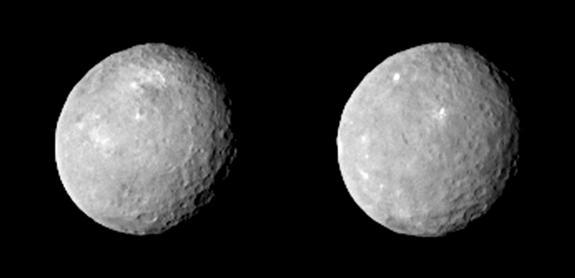
An image of Ceres taken by NASA's Dawn spacecraft shows that
the brightest spot on the dwarf planet has a dimmer companion.
NASA/JPL-Caltech/UCLA/MPS/DLR/IDA
By Mike Wall | SPACE.com
NASA's
Dawn spacecraft will have plenty of mysteries to investigate when it
begins orbiting the dwarf planet Ceres next month, as the probe's latest
photos attest.
"As we slowly approach the stage,
our eyes transfixed on Ceres and her planetary dance, we find she has
beguiled us but left us none the wiser," Dawn principal investigator
Chris Russell of UCLA said in a statement. "We expected to be surprised; we did not expect to be this puzzled."
A large, flickering white spot was also visible in photos Dawn took of Ceres last month.
"We can confirm that it is something on Ceres that reflects more sunlight, but what that is remains a mystery," Dawn mission director and chief engineer Marc Rayman, of NASA's Jet Propulsion Laboratory in Pasadena, California, told Space.com via email at the time
Dawn could clear up the mystery soon. The probe is scheduled to enter orbit around the 590-mile-wide (950 km) Ceres, the largest body in the main asteroid belt between Mars and Jupiter, on the night of March 5. Dawn will start studying Ceres in earnest six weeks after that; the probe is scheduled to work its way down to its first science orbit on April 23.
The $466 million Dawn mission launched in September 2007 to study the asteroid belt's two biggest denizens — the protoplanet Vesta, which is 330 miles (530 km) wide, and Ceres. Dawn orbited Vesta from July 2011 through September 2012, when it departed for Ceres.
Dawn's observations of these two planetary building blocks should help scientists better understand the solar system's early days, NASA officials said.
Dawn is scheduled to study Ceres from a variety of orbits through June 2016, when the probe's mission will come to an end.
********************
Things in space are certainly getting interesting and I wonder whether this is volcanic or possibly electromagnetically generated phenomena similar to Transient Lunar Phenomena?


No comments:
Post a Comment